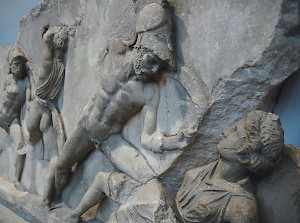Epic Cycle
Q578605Epic Cycle (᾽Επικὸς κύκλος): set of twelve archaic epic poems, known to every educated Greek. The best-known were Homer's Iliad and Odyssey, which are also the only epics that have survived.

The epic cycle tells the story of the world from the Creation to the return of the heroes of the Trojan War. The way the poems were composed is a matter of conjecture, although it seems that the Iliad and the Odyssey, attributed to Homer, are the oldest poems.
The names of the authors were already contested in Antiquity, and so where their biographies. It is likely that Lesches lived c.660 BCE while for Eugammon a floruit in c.568 is given, but that's about all we know. It does not really matter, though: all poems appear to be the result of a long oral tradition. They are essentially the product of a group process, and not compositions by an individual. What may be relevant, though, is that the poems are generally attributed to people from Asia Minor.
Modern scholars do not agree as to which epics were included in the Epic Cycle, which is probably an echo of ancient disagreement. Some include the Iliad and Odyssey, others don't; some leave out the first quartet and restrict the Epic Cycle to the Trojan poems; others include Hesiod's poetry and the Alcmaeonis, which is nothing but a name.
| Title | Author | Books | Fragments |
| Titanomachy | Eumelus of Corinth or Arctinus of Miletus | ? | 8 |
| Oedipus | Cinaethon | 11? | 3 |
| Thebais | Homer | 12? | 7-8 |
| Epigoni | Homer | 12? | 2-3 |
| Cypria | Stasinus of Cyprus, Homer, or Hegesias of Salamis | 11 | 22 |
| Iliad | Homer | 24 | complete |
| Aethiopis | Arctinus of Miletus | 5 | 3 |
| Little Iliad | Lesches of Mitylene | 4 | 14 |
| Sack of Troy | Arctinus of Miletus or Aeschylinus of Pyrrha | 2 | 10 |
| Returns | Agias of Troezen or a Colophonian | 5 | 6-7 |
| Odyssey | Homer | 24 | complete |
| Telegony | Eugammon of Cyrene | 2 | 2-3 |
The poems may originally have been meant as independent works of art, but were, in their final form, meant to supplement each other. For instance, the Cypria ends at precisely the point where the Iliad begins. The absence of overlaps and the presence of "bridges" from one epic to another, betray the hand of one or more editors. (We see the same process in the tragedies: to Euripides' Phoenician Women, several lines have been added to make it easier for the reader to continue with Sophocles' Oedipus at Colonus.) Because of this editorial activity, it comes as no surprise that several scenes (e.g., the dispute between Odysseus and Ajax about the panoply of Achilles) are attributed to two poems: not every editor made the same choice.
The final edition was probably made in Alexandria in the third century BCE, but Aristotle can already make a joke about not all cycles being epic, proving that when the Analytica Posteriora was written, an educated Greek knew that epic cycles had nothing to do with geometry.
Generally speaking, the non-Homeric poems appear to lack coherence. The Cypria mentions just everything that happened before the Iliad and has no overarching theme. Nevertheless, it is possible that the Aethiopis had a central theme - Achilles becomes the most perfect warrior of all ages and dies at the moment of supreme glory - but to this well-balanced story, a rather clumsy end has been added by an editor, who needed to create a bridge to the Little Iliad.
Except for the Iliad and the Odyssey, the poems are now lost, although for the Trojan poems, we have an excerpt by the second-century CE writer Proclus. There is also a very short summary by the anonymous author of a book called The Library, who is often called Apollodorus. The Sack of Troy has been summarized by the Roman poet Virgil in the second book of the Aeneid. There are also many works of art that help us understand the stories. However, the tragedies of Aeschylus, Sophocles, and Euripides are probably our best evidence for the original subject matter.note